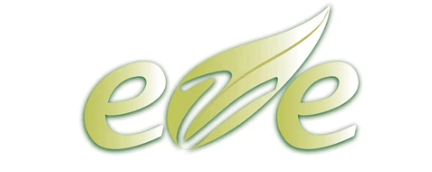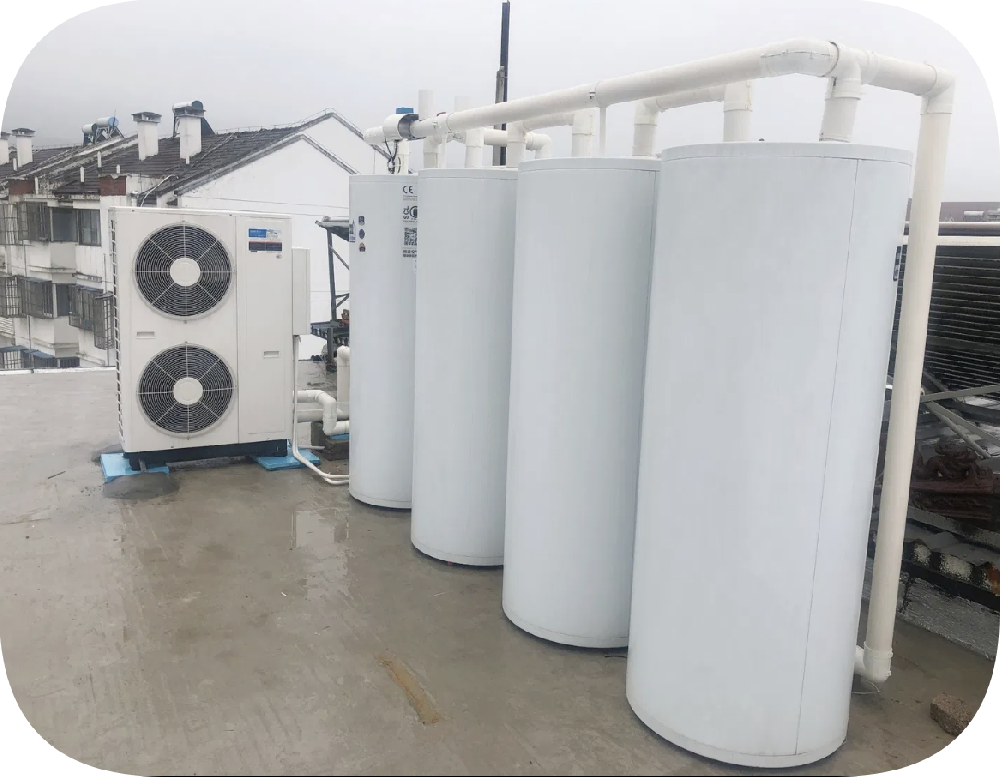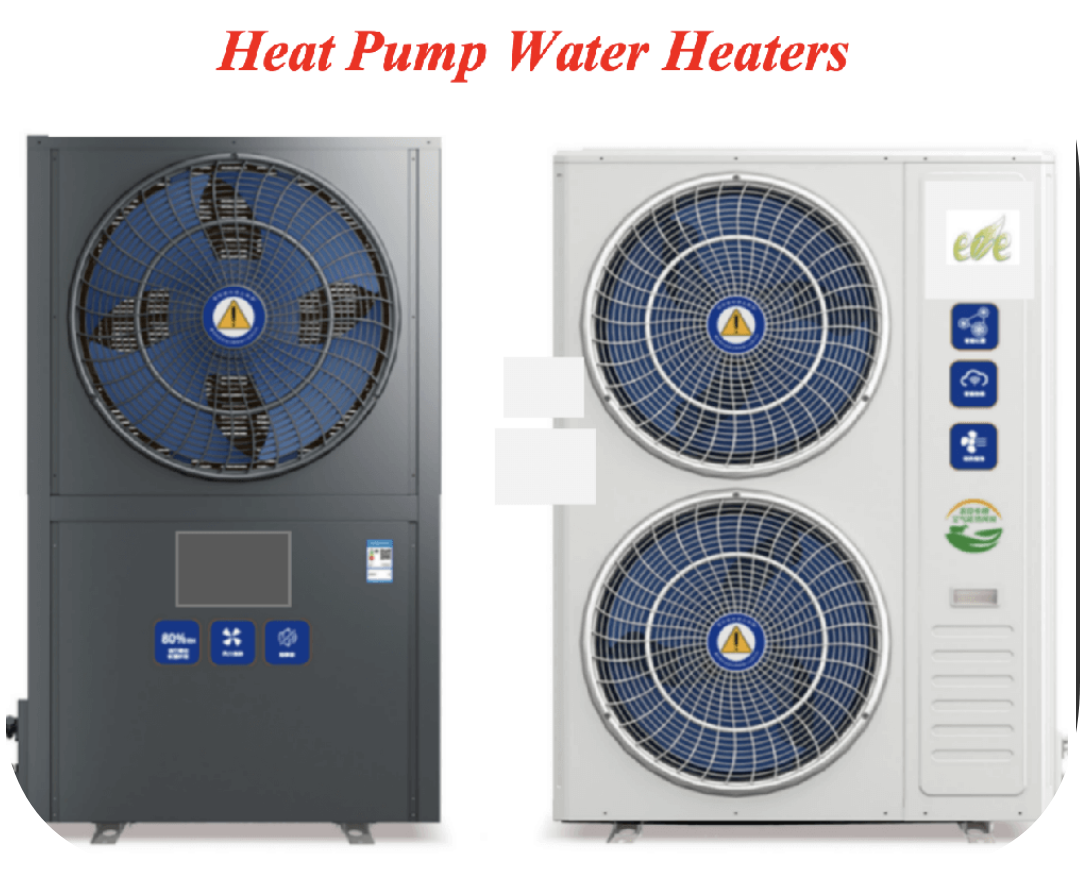Products
Calentadores de Agua con Bomba de calor
Análisis técnico en español del funcionamiento de
un calentador de agua por aerotermia
Los calentadores de agua por aerotermia (o bombas de calor aerotérmicas) son sistemas eficientes que aprovechan la energía del aire ambiente para calentar agua. Su funcionamiento se basa en termodinámica de ciclos de refrigeración, siguiendo el principio de Carnot inverso. A continuación, se detalla el proceso y los componentes clave:
1. Principio de funcionamiento
El sistema extrae calor del aire exterior (incluso a bajas temperaturas) mediante un refrigerante que circula en un circuito cerrado. Este calor se transfiere al agua mediante un intercambiador, utilizando cuatro etapas principales: evaporación, compresión, condensación y expansión.
2. Componentes y sus funciones
a) Evaporador (Evaporador)
- Función: Absorbe el calor del aire ambiente.
- Proceso: El refrigerante en estado líquido a baja presión se evapora al entrar en contacto con el aire, capturando su energía térmica.
- Partes asociadas: Aletas de intercambio térmico y ventilador para aumentar el flujo de aire.
b) Compresor (Compresor)
- Función: Aumenta la presión y temperatura del refrigerante gaseoso.
- Proceso: Mediante energía eléctrica, comprime el gas, elevando su temperatura hasta 50-80°C (ciclo termodinámico).
c) Condensador (Condensador)
- Función: Transfiere el calor del refrigerante al agua.
- Proceeso: El refrigerante caliente libera energía al agua almacenada en un depósito, condensándose de vuelta a estado líquido.
- Variante: En sistemas integrados, puede actuar como intercambiador de calor agua-refrigerante.
d) Válvula de expansión (Válvula de expansión)
- Función: Reduce la presión del refrigerante líquido.
- Proceso: Crea un estrangulamiento que enfría abruptamente el refrigerante, preparándolo para reiniciar el ciclo.
e) Depósito de agua (Tanque de almacenamiento)
- Función: Almacena agua caliente para uso doméstico.
- Características: Suele incluir aislamiento térmico para minimizar pérdidas de calor.
f) Ventilador (Ventilador)
- Función: Mejora la eficiencia del evaporador al forzar el flujo de aire sobre sus aletas.
g) Unidad de control (Unidad de control electrónica)
- Función: Regula la temperatura, presión y ciclos del sistema mediante sensores y actuadores.
3. Proceso de trabajo (paso a paso)
1. Absorción de calor (Evaporador)
- El refrigerante frío absorbe calor del aire, evaporándose a ≈-10°C.
2. Compresión (Compresor)
- El gas se comprime, alcanzando altas temperaturas (≈80°C).
3. Transferencia al agua (Condensador)
- El gas caliente cede calor al agua, condensándose (≈40-60°C).
4. Expansión (Válvula)
- El líquido se enfría bruscamente, reiniciando el ciclo.
4. Ventajas clave
- Eficiencia energética: Producen 3-4 kW térmicos por 1 kW eléctrico consumido (COP ≈3-4).
- Bajas emisiones: Ideales para transición energética.
- Funcionamiento en climas fríos: Operan hasta ≈-15°C (modelos avanzados)
Diagrama simplificado del circuito
Aire exterior → Evaporador → Compresor → Condensador (agua) → Válvula de expansión → (ciclo se repite)
Este sistema es ampliamente utilizado en Europa y Asia por su sostenibilidad, destacando marcas como Daikin, Mitsubishi o Hitachi. ¿Necesitas más detalles sobre algún componente específico?
Aquí tienes una explicación del principio de funcionamiento y proceso de los calentadores de agua por bomba de calor en español
Principio de funcionamiento
Los calentadores de agua por bomba de calor (también llamados termos de bomba de calor) utilizan un ciclo termodinámico para transferir calor del aire ambiente al agua, en lugar de generarlo directamente mediante electricidad o combustión. Funcionan de manera similar a un aire acondicionado o refrigerador, pero en reversa: extraen calor del aire circundante y lo transfieren al agua almacenada.
Proceso paso a paso
1. Absorción de calor del aire ambiente
- Un ventilador aspira el aire exterior o del entorno (incluso a bajas temperaturas).
- El evaporador (con un refrigerante en su interior) absorbe el calor del aire, lo que hace que el refrigerante se evapore y se convierta en gas.
2. Compresión del gas refrigerante
- El gas caliente pasa al compresor, donde se comprime, aumentando su temperatura y presión significativamente.
3. Transferencia de calor al agua
- El gas sobrecalentado fluye hacia el condensador (intercambiador de calor), que está en contacto con el tanque de agua.
- El calor del gas se transfiere al agua, calentándola. Durante este proceso, el refrigerante vuelve a su estado líquido.
4. Expansión del refrigerante
- El líquido refrigerante pasa por una válvula de expansión, donde reduce su presión y temperatura, preparándose para reiniciar el ciclo.
5. Recirculación
- El ciclo se repite hasta que el agua alcanza la temperatura deseada (normalmente entre 50-60°C).
Ventajas clave
- Eficiencia energética: Consumen hasta un 70-80% menos de energía que un calentador eléctrico tradicional, ya que mueven calor en lugar de generarlo.
- Funcionamiento en frío: Aunque son más eficientes en climas cálidos, incluso pueden extraer calor de ambientes con temperaturas bajo cero.
- Amigables con el medio ambiente: Reducen las emisiones de CO₂ al depender menos de la electricidad.
Notas importantes
- El aire que sale del sistema está más frío que el ambiente original, lo que puede ser útil para ventilar espacios calurosos (por ejemplo, en sótanos o lavanderías).
- Requieren un espacio ventilado para funcionar óptimamente, ya que dependen del flujo de aire.
En resumen, estos sistemas aprovechan la energía térmica disponible en el aire, convirtiéndolos en una opción sostenible y económica para el calentamiento de agua.
Calentadores de Agua con Bomba de Calor
Aplicaciones de las bombas de calor para agua caliente (heat pump water heaters):
1. Sector residencial y hotelero: Calentamiento de agua sanitaria para duchas, lavado y calefacción.
2. Piscinas: Mantenimiento de temperatura en piscinas residenciales, hoteleras o deportivas.
3. Agricultura y ganadería: Calefacción de invernaderos, agua para limpieza de equipos o bebederos de animales.
4. Industria: Precalentamiento de agua para procesos industriales, lavado de maquinaria o sistemas de limpieza.
5. Sector comercial: Gimnasios, hospitales y centros comerciales que requieren agua caliente constante.
Principio de funcionamiento:
Las bombas de calor extraen energía térmica del aire ambiente (incluso a bajas temperaturas) mediante un refrigerante. Este absorbe calor, se comprime para elevar su temperatura y transfiere la energía al agua a través de un intercambiador. Consumen hasta un 75% menos de electricidad que los calentadores eléctricos tradicionales, ya que aprovechan energía renovable del aire, reduciendo costos y emisiones.
Ventajas clave:
- Alta eficiencia energética (COP de 3-4).
- Funcionamiento en climas variados (hasta -10°C).
- Reducción de huella de carbono comparado con sistemas de gas o eléctricos.
Este resumen es ideal para presentaciones técnicas o comunicación con clientes potenciales en sectores estratégicos de Latinoamérica.
¿Necesitas adaptarlo a un caso específico?





